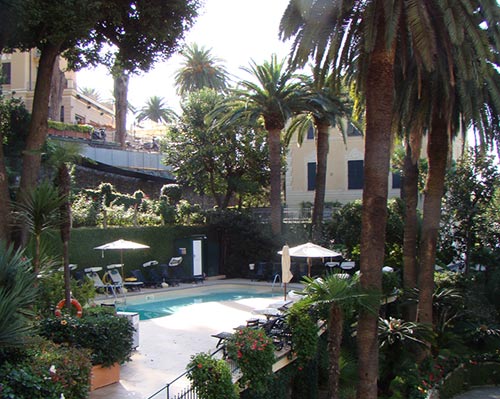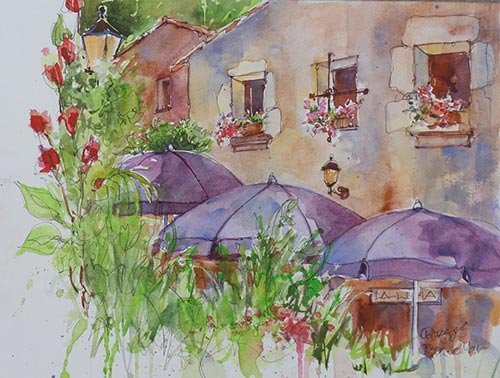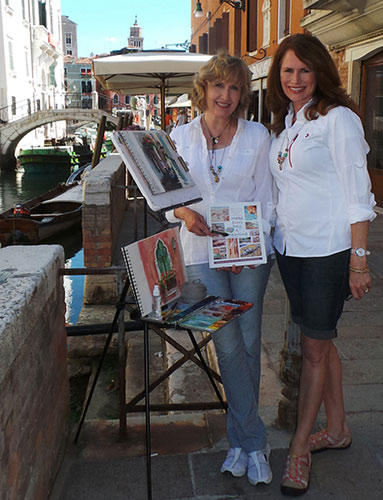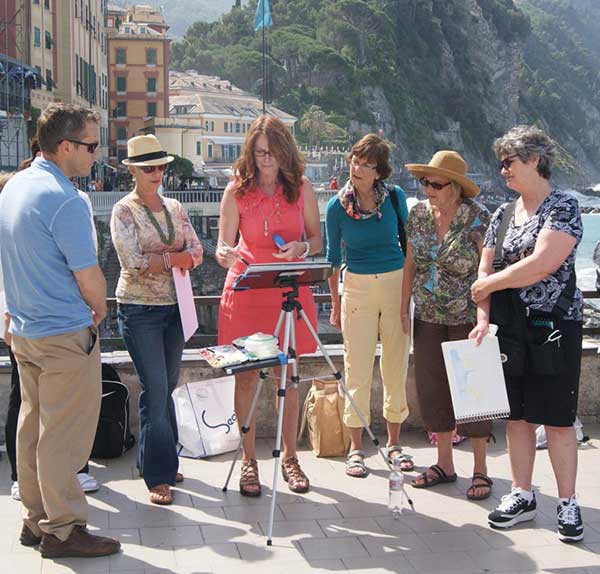This is the first in a three-part series in which Cindy Briggs and Theresa Goesling share their expertise on running painting workshops overseas — or at least outside of one’s studio. In this first installment, we explore the planning and preparation of a workshop. Part II will look at marketing, and Part III will examine the execution of a successful workshop.
Lead Image: Theresa Goesling, of Make Every Day a Painting Workshops, offers a demo in Camogli, Italy
The first step in planning a painting workshop is determining if one will host it in the studio or travel abroad. Holding a workshop in one’s own studio will of course cut down on overhead costs. But space may be an issue, and liability remains a problem. Plus, holding a workshop in a beautiful place goes a long way in filling up the slots. It is often worth venturing out.
Goesling and Briggs teach workshops in Europe, and it’s clear that one of the main reasons is because they enjoy the destinations. In fact, while it makes sense in many ways to return to the same city repeatedly, they mix it up. “We don’t want to repeat the same location too much,” says Briggs. “We listen to where our participants want to go — but it’s also where we want to go.”

Briggs and Goesling, who together form the company Make Every Day a Painting Workshops, determine new locations in part through the tough research of visiting beautiful places. “When we taught in Venice we previewed three other places on the same trip,” says Briggs. “We check out the hotels, the transportation system, painting spots, meet with concierges.” If a destination looks good, the duo starts to plan out the general shape of the workshop, and begins to assay the likely expenses. This is a complicated step. The workshop leader must factor in many things, including the exchange rate (which can be quite variable depending on time of year), lodging, dining, airfare, local transportation, and personal expenses. Goesling and Briggs recommend putting all those costs into a spreadsheet to see what would need to be charged to make a profit.
“Sometimes you can hit your revenue target by adjusting how long the workshop lasts,” says Briggs. “You may have a shorter workshop in Venice, for example, which is very expensive. You come up with a fee per day, and then see how long you can stay and still offer a competitive price.” Many travel workshops charge $2,800 to $3,500 these days. Briggs and Goesling’s company offers a spreadsheet to help instructors calculate costs.

One area with a lot of leeway is lodging. Briggs reports that they often negotiate effectively with hotels, in particular regarding the deposit. “The first year in Italy we paid a huge deposit for 50 percent of the room nights, which was a big risk — over $10,000!,” says the artist. “We’ve discovered ways to negotiate room rates and cancellation options, and paying deposits for guest rooms on hold as we get signups. We also arrange a group discount and make commissions on each room. Now our accommodation deposits upfront are about $1,200-$2,000, with options to cancel on a specified date. The hotel just wants to know you are filling the rooms, so we stay in touch and pay the ‘non-refundable’ deposits as we get them.” Briggs says to account for taxes, surcharges, and tips when appropriate.
Two expenses may surprise a new instructor. Briggs advises that artists hire a lawyer to set up a Limited Liability Company (LLC) to protect against lawsuits. “What’s nice about an LLC is you only have to set it up once, and then you just keep it up,” she says. “Many artists go with an established company so they don’t have to worry about liability. We’ve done that, too. Sometimes we just want to go somewhere new, and we don’t know the area, and a company has a great package. It’s up to you if you want to get into that. But you need to protect yourself if someone cancels. We encourage trip insurance.”

The other expense is a second person. “You need a second person,” Briggs says simply. “If you aren’t bringing another instructor, you need an assistant to take care of the personal needs of the participants. We are both teachers, so we can take turns demoing or helping students. Having two people allows an instructor to spend more time with students.”




